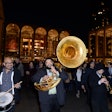
Citing considerable work for a small return, Kara Logan canceled Harlem RBI's silent auction in 2006—and then brought it back this year.
Photo: Francine Daveta for BizBash
Talking to Maria-Nelly Johnson, the director of finance and administration for Special Olympics District of Columbia, you can tell she has deep affection for the Night of Trees, the organization’s 22-year-old fund-raising event. You can also tell she kind of hates it.
On the first Friday after Thanksgiving weekend, the nonprofit typically hosts as many as 900 guests, who take in a buffet, an open bar, a band, a live auction, and the big draw: a silent auction of about 200 items—including 15 to 20 predecorated Christmas trees (hence the name). It’s the silent auction that makes Johnson sound tired just talking about the benefit. “It’s extremely demanding, timewise,” she says. “I think we keep doing it because it’s become a tradition.”Among the duties involved in organizing the massive silent auction (which begin as early as June) are constant faxing and following up to get items donated, waiting for confirmation and details on those items, writing the auction program (often at the last minute), and making sure the document is accurate. Add to that 60- to 70-hour weeks throughout November and the marshaling of an army of volunteers on the big night. “The time spent with the follow-up calls and waiting to receive the items is the part I don’t enjoy,” Johnson says.
It’s enough to make anyone ask: Is it worth it? Especially when live auctions, with their frequently sexy and exclusive offerings, can often haul in tens of thousands of dollars or more for a handful of lots in less than a half hour, compared with the smaller take of a silent auction, for which the starting price of items is typically much lower.
Johnson isn’t the only one feeling the pain of producing a silent auction. “People don’t understand the amount of effort it takes to get a good group of items,” says one strongly anti-silent auction event professional, who didn’t want to be named because her clients still require her to work on them. “It rarely gives you the bang for your buck. Silent auctions are much too labor intensive.”
Kara Logan, director of development at Harlem RBI, an organization that oversees baseball and softball programs for young people, recently weighed the time and effort that went into planning a silent auction against the amount of money the platform raised. One year, the silent auction at the organization’s annual Bids for Kids benefit brought in just $35,000 of the event’s overall take of more than $1 million. “When you’re raising a million dollars, that isn’t that much money,” she says, “especially considering the amount of work it takes to acquire the items.”
Logan estimates that at least 60 hours between two staffers goes into organizing Harlem RBI’s silent auction. “Which is a lot, considering all the other things that go into pulling an event for 650 people off,” she says. “The last week, we’re all working on it, calling everyone we’ve ever met. I don’t think, unless you’d done it before, you would ever anticipate the amount of work it is.”
Logan’s list of time-consuming, labor intensive, or just plain annoying duties: hunting down items, pricing them, making sure they’re framed correctly, writing descriptions, pulling together the auction book (while items are still coming in), and coordinating the checkout process, which several planners call a “nightmare.” (After a long night and several drinks, all of the guests want to go home—but wait! It’s time to go pick up the item they bought, along with everyone else, who did the same thing.)
Taking into account all of these factors, Logan made the pragmatic decision to nix the silent auction in 2006. But this year, it’s back. Why? “Donors missed it,” Logan says. “At the end of the day, development is about taking care of people so they’ll want to take care of the organization. It’s worth it to make people happy.” This year’s auction—which included a week’s vacation in Hilton Head, South Carolina; a pair of 25th-anniversary Nike Air Force Ones; and a package of baseballs signed by Sandy Koufax, Ted Williams, and Willie Mays—drew $27,000.
Rosemary Mackey, chief external affairs officer at the American Red Cross in greater New York, also decided to forgo a silent auction for the organization’s Red Cross ball this past March, citing not only the work involved in pulling together the lots but also the physical space it would occupy. “The cost/benefit of getting things and the money they made, as well as the space they took up, were huge factors for us,” she says. “Once you get more than 500 people in a space and you have a silent auction as well, it doesn’t work. I think people like to mingle and walk around, and the silent auction takes space away.”
Was Mackey met with pleas from donors to reinstate the silent auction? Well, no. In fact, Mackey gives a good deal of credit to the lively live auction, scheduled for the end of the evening, as the source of the positive feedback she’s received on the event. “We’ve gotten so many comments saying it was fun and not boring,” she says. “They had the taste of the live auction in their mouth when they left.”
So aside from honoring tradition (while still raising some funds) and keeping much appreciated donors happy, is there any reason to take on this labor-intensive, low-return, staff exhausting venture? It turns out: yes.
Logan points out that not everybody has the cash to buy a $100,000 intimate getaway with Brangelina in the Maldives but that most guests want to show some support. “You have a handful of people paying for tables, and then you have their guests. They want to buy something, and the silent auction gives them the opportunity to contribute,” she says. “Nobody wants to be the person who went to the party for free.”
And then there’s the issue of the audience. “A young crowd may not be as excited to sit and raise a paddle for $50,000,” says Angela Nevarez, special events director at the New Museum of Contemporary Art, who worked on a six-item silent auction at a benefit concert for Rhizome, a New Museum affiliate.
Still others, like Pam Sharp, owner of Los Angeles firm Sharp & Associates, say it all comes down to the items up for bid. “It depends entirely on what you have,” she says. “If you have great stuff, a silent auction is wonderful.”
One of the staunchest defenders of the silent auction is, believe it or not, Johnson, the beleaguered Night of Trees organizer. Some donors, she says, just aren’t the live-auction type. “Only 20 percent of people participate in the live auction. A lot of people don’t feel comfortable with a live auction. I’ve seen people spend six to seven thousand dollars in a silent auction who will never raise their paddle in a live auction, because they don’t feel comfortable. They don’t like it,” she says. “Those same people are almost parked next to the bid sheets.”
Even so, Johnson probably has a number of reasons to justify dismantling the event. When the Night of Trees was born, it served as the main fund-raiser for her organization, but now it accounts for just a third of the annual budget. Of course, the demand on her staff and resources is considerable—and when she’s asked, other people’s disappointment aside, if she would cancel the Night of Trees, she wearily replies, “Yeah.” Still, she’s preparing for the 2007 incarnation right now. “Seeing the lobby, with all the Christmas trees—it’s a big thing for everybody,” she says.
Johnson does admit that if the organization dreamed up another event that could bring in more income with less work, the Night of Trees might be deforested. “But right now I don’t see that happening,” she says. “We’ve signed a contract [with the Omni Hotel] to do it for the next four years.”
On the first Friday after Thanksgiving weekend, the nonprofit typically hosts as many as 900 guests, who take in a buffet, an open bar, a band, a live auction, and the big draw: a silent auction of about 200 items—including 15 to 20 predecorated Christmas trees (hence the name). It’s the silent auction that makes Johnson sound tired just talking about the benefit. “It’s extremely demanding, timewise,” she says. “I think we keep doing it because it’s become a tradition.”Among the duties involved in organizing the massive silent auction (which begin as early as June) are constant faxing and following up to get items donated, waiting for confirmation and details on those items, writing the auction program (often at the last minute), and making sure the document is accurate. Add to that 60- to 70-hour weeks throughout November and the marshaling of an army of volunteers on the big night. “The time spent with the follow-up calls and waiting to receive the items is the part I don’t enjoy,” Johnson says.
It’s enough to make anyone ask: Is it worth it? Especially when live auctions, with their frequently sexy and exclusive offerings, can often haul in tens of thousands of dollars or more for a handful of lots in less than a half hour, compared with the smaller take of a silent auction, for which the starting price of items is typically much lower.
Johnson isn’t the only one feeling the pain of producing a silent auction. “People don’t understand the amount of effort it takes to get a good group of items,” says one strongly anti-silent auction event professional, who didn’t want to be named because her clients still require her to work on them. “It rarely gives you the bang for your buck. Silent auctions are much too labor intensive.”
Kara Logan, director of development at Harlem RBI, an organization that oversees baseball and softball programs for young people, recently weighed the time and effort that went into planning a silent auction against the amount of money the platform raised. One year, the silent auction at the organization’s annual Bids for Kids benefit brought in just $35,000 of the event’s overall take of more than $1 million. “When you’re raising a million dollars, that isn’t that much money,” she says, “especially considering the amount of work it takes to acquire the items.”
Logan estimates that at least 60 hours between two staffers goes into organizing Harlem RBI’s silent auction. “Which is a lot, considering all the other things that go into pulling an event for 650 people off,” she says. “The last week, we’re all working on it, calling everyone we’ve ever met. I don’t think, unless you’d done it before, you would ever anticipate the amount of work it is.”
Logan’s list of time-consuming, labor intensive, or just plain annoying duties: hunting down items, pricing them, making sure they’re framed correctly, writing descriptions, pulling together the auction book (while items are still coming in), and coordinating the checkout process, which several planners call a “nightmare.” (After a long night and several drinks, all of the guests want to go home—but wait! It’s time to go pick up the item they bought, along with everyone else, who did the same thing.)
Taking into account all of these factors, Logan made the pragmatic decision to nix the silent auction in 2006. But this year, it’s back. Why? “Donors missed it,” Logan says. “At the end of the day, development is about taking care of people so they’ll want to take care of the organization. It’s worth it to make people happy.” This year’s auction—which included a week’s vacation in Hilton Head, South Carolina; a pair of 25th-anniversary Nike Air Force Ones; and a package of baseballs signed by Sandy Koufax, Ted Williams, and Willie Mays—drew $27,000.
Rosemary Mackey, chief external affairs officer at the American Red Cross in greater New York, also decided to forgo a silent auction for the organization’s Red Cross ball this past March, citing not only the work involved in pulling together the lots but also the physical space it would occupy. “The cost/benefit of getting things and the money they made, as well as the space they took up, were huge factors for us,” she says. “Once you get more than 500 people in a space and you have a silent auction as well, it doesn’t work. I think people like to mingle and walk around, and the silent auction takes space away.”
Was Mackey met with pleas from donors to reinstate the silent auction? Well, no. In fact, Mackey gives a good deal of credit to the lively live auction, scheduled for the end of the evening, as the source of the positive feedback she’s received on the event. “We’ve gotten so many comments saying it was fun and not boring,” she says. “They had the taste of the live auction in their mouth when they left.”
So aside from honoring tradition (while still raising some funds) and keeping much appreciated donors happy, is there any reason to take on this labor-intensive, low-return, staff exhausting venture? It turns out: yes.
Logan points out that not everybody has the cash to buy a $100,000 intimate getaway with Brangelina in the Maldives but that most guests want to show some support. “You have a handful of people paying for tables, and then you have their guests. They want to buy something, and the silent auction gives them the opportunity to contribute,” she says. “Nobody wants to be the person who went to the party for free.”
And then there’s the issue of the audience. “A young crowd may not be as excited to sit and raise a paddle for $50,000,” says Angela Nevarez, special events director at the New Museum of Contemporary Art, who worked on a six-item silent auction at a benefit concert for Rhizome, a New Museum affiliate.
Still others, like Pam Sharp, owner of Los Angeles firm Sharp & Associates, say it all comes down to the items up for bid. “It depends entirely on what you have,” she says. “If you have great stuff, a silent auction is wonderful.”
One of the staunchest defenders of the silent auction is, believe it or not, Johnson, the beleaguered Night of Trees organizer. Some donors, she says, just aren’t the live-auction type. “Only 20 percent of people participate in the live auction. A lot of people don’t feel comfortable with a live auction. I’ve seen people spend six to seven thousand dollars in a silent auction who will never raise their paddle in a live auction, because they don’t feel comfortable. They don’t like it,” she says. “Those same people are almost parked next to the bid sheets.”
Even so, Johnson probably has a number of reasons to justify dismantling the event. When the Night of Trees was born, it served as the main fund-raiser for her organization, but now it accounts for just a third of the annual budget. Of course, the demand on her staff and resources is considerable—and when she’s asked, other people’s disappointment aside, if she would cancel the Night of Trees, she wearily replies, “Yeah.” Still, she’s preparing for the 2007 incarnation right now. “Seeing the lobby, with all the Christmas trees—it’s a big thing for everybody,” she says.
Johnson does admit that if the organization dreamed up another event that could bring in more income with less work, the Night of Trees might be deforested. “But right now I don’t see that happening,” she says. “We’ve signed a contract [with the Omni Hotel] to do it for the next four years.”



















